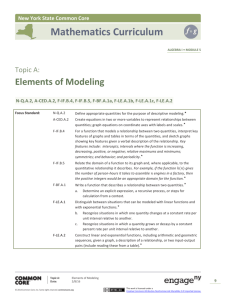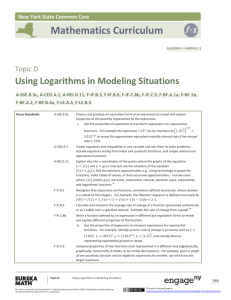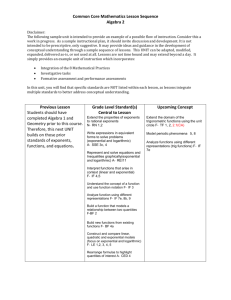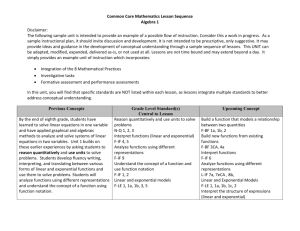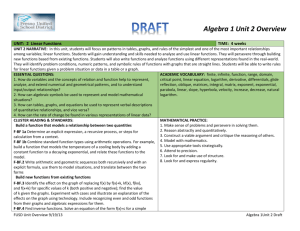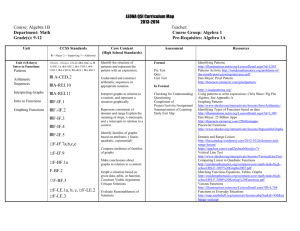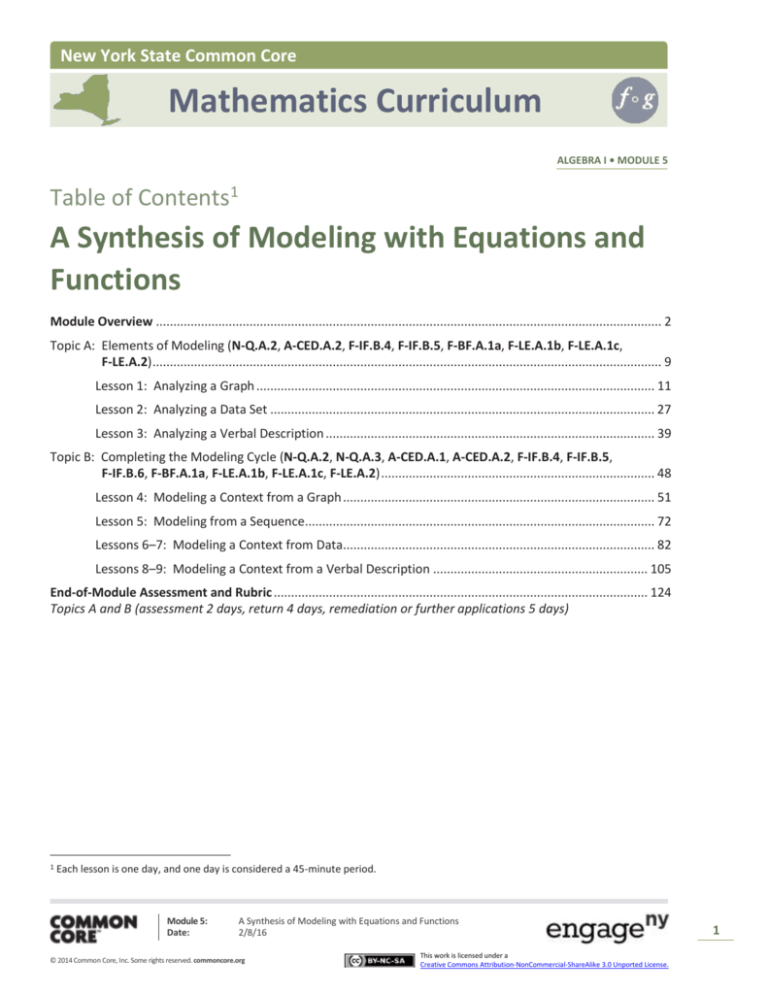
New York State Common Core
Mathematics Curriculum
ALGEBRA I • MODULE 5
Table of Contents1
A Synthesis of Modeling with Equations and
Functions
Module Overview .................................................................................................................................................. 2
Topic A: Elements of Modeling (N-Q.A.2, A-CED.A.2, F-IF.B.4, F-IF.B.5, F-BF.A.1a, F-LE.A.1b, F-LE.A.1c,
F-LE.A.2) ................................................................................................................................................... 9
Lesson 1: Analyzing a Graph ................................................................................................................... 11
Lesson 2: Analyzing a Data Set ............................................................................................................... 27
Lesson 3: Analyzing a Verbal Description ............................................................................................... 39
Topic B: Completing the Modeling Cycle (N-Q.A.2, N-Q.A.3, A-CED.A.1, A-CED.A.2, F-IF.B.4, F-IF.B.5,
F-IF.B.6, F-BF.A.1a, F-LE.A.1b, F-LE.A.1c, F-LE.A.2) ............................................................................... 48
Lesson 4: Modeling a Context from a Graph .......................................................................................... 51
Lesson 5: Modeling from a Sequence..................................................................................................... 72
Lessons 6–7: Modeling a Context from Data.......................................................................................... 82
Lessons 8–9: Modeling a Context from a Verbal Description .............................................................. 105
End-of-Module Assessment and Rubric ............................................................................................................ 124
Topics A and B (assessment 2 days, return 4 days, remediation or further applications 5 days)
1
Each lesson is one day, and one day is considered a 45-minute period.
Module 5:
Date:
A Synthesis of Modeling with Equations and Functions
2/8/16
© 2014 Common Core, Inc. Some rights reserved. commoncore.org
This work is licensed under a
Creative Commons Attribution-NonCommercial-ShareAlike 3.0 Unported License.
1
Module Overview
NYS COMMON CORE MATHEMATICS CURRICULUM
M5
ALGEBRA I
Algebra I • Module 5
A Synthesis of Modeling with Equations and
Functions
OVERVIEW
In Grade 8, students used functions for the first time to construct a function that models a linear relationship
between two quantities (8.F.B.4) and to describe qualitatively the functional relationship between two
quantities by analyzing a graph (8.F.B.5). In the first four modules of Algebra I, students learn to create and
apply linear, quadratic, and exponential functions in addition to square and cube root functions (F-IF.C.7). In
Module 5, they synthesize what they have learned during the year by selecting the correct function type in a
series of modeling problems without the benefit of a module or lesson title that includes function type to
guide them in their choices. This supports the CCLS requirement that student’s use the modeling cycle, in the
beginning of which they must formulate a strategy. Skills and knowledge from the previous modules will
support the requirements of this module, including writing, rewriting, comparing, and graphing functions
(F-IF.C.7, F-IF.C.8, F-IF.C.9) and interpretation of the parameters of an equation (F-LE.B.5). Students also
draw on their study of statistics in Module 2, using graphs and functions to model a context presented with
data and tables of values (S-ID.B.6). In this module, we use the modeling cycle (see page 72 of the CCLS) as
the organizing structure rather than function type.
Topic A focuses on the skills inherent in the modeling process: representing graphs, data sets, or verbal
descriptions using explicit expressions (F-BF.A.1a). Information is presented in graphic form in Lesson 1, as
data in Lesson 2, and as a verbal description of a contextual situation in Lesson 3. Students recognize the
function type associated with the problem (F-LE.A.1b, F-LE.A.1c) and match to or create 1- and 2-variable
equations (A-CED.A.1, A-CED.A.2) to model a context presented graphically, as a data set, or as a description
(F-LE.A.2). Function types include linear, quadratic, exponential, square root, cube root, absolute value, and
other piecewise functions. Students interpret features of a graph in order to write an equation that can be
used to model it and the function (F-IF.B.4, F-BF.A.1) and relate the domain to both representations
(F-IF.B.5). This topic focuses on the skills needed to complete the modeling cycle and sometimes uses purely
mathematical models, sometimes real-world contexts.
Module 5:
Date:
A Synthesis of Modeling with Equations and Functions
2/8/16
© 2014 Common Core, Inc. Some rights reserved. commoncore.org
This work is licensed under a
Creative Commons Attribution-NonCommercial-ShareAlike 3.0 Unported License.
2
Module Overview
NYS COMMON CORE MATHEMATICS CURRICULUM
M5
ALGEBRA I
Tables, graphs, and equations all represent models. We use terms such as “symbolic” or “analytic” to refer
specifically to the equation form of a function model; “descriptive model” refers to a model that seeks to
describe or summarize phenomena, such as a graph. In Topic B, students expand on their work in Topic A to
complete the modeling cycle for a real-world contextual problem presented as a graph, a data set, or a verbal
description. For each, they formulate a function model, perform computations related to solving the
problem, interpret the problem and the model, and then validate through iterations of revising their models
as needed, and report their results.
Students choose and define the quantities of the problem (N-Q.A.2) and the appropriate level of precision for
the context (N-Q.A.3). They create 1- and 2-variable equations (A-CED.A.1, A-CED.A.2) to model the context
when presented as a graph, as data, and as a verbal description. They can distinguish between situations that
represent a linear (F-LE.A.1b), quadratic, or exponential (F-LE.A.1c) relationship. For data, they look for first
differences to be constant for linear relationships, second differences to be constant for quadratic
relationships, and a common ratio for exponential relationships. When there are clear patterns in the data,
students will recognize when the pattern represents a linear (arithmetic) or exponential (geometric) sequence
(F-BF.A.1a, F-LE.A.2). For graphic presentations, students interpret the key features of the graph, and for
both data sets and verbal descriptions, students sketch a graph to show the key features (F-IF.B.4). They
calculate and interpret the average rate of change over an interval, estimating when using the graph
(F-IF.B.6), and relate the domain of the function to its graph and to its context (F-IF.B.5).
Focus Standards
Reason quantitatively and use units to solve problems.
N-Q.A.22
Define appropriate quantities for the purpose of descriptive modeling.★
N-Q.A.33
Choose a level of accuracy appropriate to limitations on measurement when reporting
quantities.★
Create equations that describe numbers or relationships.
A-CED.A.14 Create equations and inequalities in one variable and use them to solve problems. Include
equations arising from linear and quadratic functions, and simple rational and exponential
functions.★
A-CED.A.2
Create equations in two or more variables to represent relationships between quantities;
graph equations on coordinate axes with labels and scales.★
2
This standard will be assessed in Algebra I by ensuring that some modeling tasks (involving Algebra I content or securely-held
content from Grades 6–8) require the student to create a quantity of interest in the situation being described.
3 The greatest precision for a result is only at the level of the least precise data point (e.g., if units are tenths and hundredths, then the
appropriate level of precision is tenths). Calculation of relative error is not included in this standard (in preparation for Regents
Exams).
4 In Algebra I, tasks are limited to linear, quadratic, or exponential equations with integer exponents.
Module 5:
Date:
A Synthesis of Modeling with Equations and Functions
2/8/16
© 2014 Common Core, Inc. Some rights reserved. commoncore.org
This work is licensed under a
Creative Commons Attribution-NonCommercial-ShareAlike 3.0 Unported License.
3
Module Overview
NYS COMMON CORE MATHEMATICS CURRICULUM
M5
ALGEBRA I
Interpret functions that arise in applications in terms of the context.
F-IF.B.45
For a function that models a relationship between two quantities, interpret key features of
graphs and tables in terms of the quantities, and sketch graphs showing key features given a
verbal description
of the relationship. Key features include: intercepts; intervals where the
function is increasing, decreasing, positive, or negative; relative maximums and minimums;
symmetries; end behavior; and periodicity.★
F-IF.B.5
Relate the domain of a function to its graph and, where applicable, to the quantitative
relationship it describes. For example, if the function ℎ(𝑛) gives the number of person-hours
it takes to assemble 𝑛 engines in a factory, then the positive integers would be an
appropriate domain for the function.★
F-IF.B.66
Calculate and interpret the average rate of change of a function (presented symbolically or
★
as a table) over a specified interval. Estimate the rate of change from a graph.
Build a function that models a relationship between two quantities.
F-BF.A.17
Write a function that describes a relationship between two quantities.★
a.
Determine an explicit expression, a recursive process, or steps for calculation from a
context.
Construct and compare linear, quadratic, and exponential models and solve problems.
F-LE.A.1
F-LE.A.28
Distinguish between situations that can be modeled with linear functions and with
exponential functions.★
b.
Recognize situations in which one quantity changes at a constant rate per unit interval
relative to another.
c.
Recognize situations in which a quantity grows or decays by a constant percent rate per
unit interval relative to another.
Construct linear and exponential functions, including arithmetic and geometric sequences,
given a graph, a description of a relationship, or two input-output pairs (include reading
these from a table).★
5
Tasks have a real-world context. In Algebra I, tasks are limited to linear, quadratic, square root, cube root, piecewise-defined
(including step and absolute value functions), and exponential functions with domains in the integers.
6
Tasks have a real-world context. In Algebra I, tasks are limited to linear, quadratic, square root, cube root, piecewise-defined
(including step functions and absolute value functions), and exponential functions with domains in the integers.
7 Tasks have a real-world context. In Algebra I, tasks are limited to linear functions, quadratic functions, and exponential functions
with domains in the integers.
8 In Algebra I, tasks are limited to constructing linear and exponential functions in simple context (not multi-step).
Module 5:
Date:
A Synthesis of Modeling with Equations and Functions
2/8/16
© 2014 Common Core, Inc. Some rights reserved. commoncore.org
This work is licensed under a
Creative Commons Attribution-NonCommercial-ShareAlike 3.0 Unported License.
4
Module Overview
NYS COMMON CORE MATHEMATICS CURRICULUM
M5
ALGEBRA I
Foundational Standards
Use functions to model relationships between quantities.
8.F.B.4
Construct a function to model a linear relationship between two quantities. Determine the
rate of change and initial value of the function from a description of a relationship or from
two (𝑥, 𝑦) values, including reading these from a table or from a graph. Interpret the rate of
change and initial value of a linear function in terms of the situation it models, and in terms
of its graph or a table of values.
8.F.B.5
Describe qualitatively the functional relationship between two quantities by analyzing a
graph (e.g., where the function is increasing or decreasing, linear or nonlinear). Sketch a
graph that exhibits the qualitative features of a function that has been described verbally.
Analyze functions using different representations.
F-IF.C.7
Graph functions expressed symbolically and show key features of the graph, by hand in
simple cases and using technology for more complicated cases.★
a. Graph linear and quadratic functions and show intercepts, maxima, and minima.
b. Graph square root, cube root, and piecewise-defined functions, including step functions
and absolute value functions.
F-IF.C.8
Write a function defined by an expression in different but equivalent forms to reveal and
explain different properties of the function.
c. Use the process of factoring and completing the square in a quadratic function to show
zeros, extreme values, and symmetry of the graph, and interpret these in terms of a
context.
F-IF.C.99
Compare properties of two functions each represented in a different way (algebraically,
graphically, numerically in tables, or by verbal descriptions). For example, given a graph of
one quadratic function and an algebraic expression for another, say which has the larger
maximum.
Interpret expressions for functions in terms of the situation they model.
F-LE.B.510
Interpret the parameters in a linear or exponential function in terms of a context.★
9
In Algebra I, tasks are limited to linear functions, quadratic functions, square root functions, cube root functions, piecewise-defined
functions (including step functions and absolute value functions), and exponential functions with domains in the integers.
10 Tasks have a real-world context. In Algebra I, exponential functions are limited to those with domains in the integers.
Module 5:
Date:
A Synthesis of Modeling with Equations and Functions
2/8/16
© 2014 Common Core, Inc. Some rights reserved. commoncore.org
This work is licensed under a
Creative Commons Attribution-NonCommercial-ShareAlike 3.0 Unported License.
5
Module Overview
NYS COMMON CORE MATHEMATICS CURRICULUM
M5
ALGEBRA I
Summarize, represent, and interpret data on two categorical and quantitative variables.
S-ID.B.611
Represent data on two quantitative variables on a scatter plot, and describe how the
variables are related.
d.
Fit a function to the data; use functions fitted to data to solve problems in the context
of the data. Use given functions or choose a function suggested by the context.
Emphasize linear, quadratic, and exponential models.
e.
Informally assess the fit of a function by plotting and analyzing residuals.
Focus Standards for Mathematical Practice
11
MP.1
Make sense of problems and persevere in solving them. Mathematically proficient
students start by explaining to themselves the meaning of a problem and looking for entry
points to its solution. They analyze givens, constraints, relationships, and goals. In Module
5, students make sense of the problem by analyzing the critical components of the problem,
presented as a verbal description, a data set, or a graph and persevere in writing the
appropriate function that describes the relationship between two quantities. Then, they
interpret the function in the context.
MP.2
Reason abstractly and quantitatively. Mathematically proficient students make sense of
quantities and their relationships in problem situations. This module alternates between
algebraic manipulation of expressions and equations and interpreting the quantities in the
relationship in terms of the context. In Topic A, students develop fluency in recognizing and
identifying key features of the three primary function types studied in Algebra I, as well as
manipulating expressions to highlight those features. Topic B builds on these skills so that
when students are given a verbal description of a situation that can be described by a
function, they decontextualize it and apply the skills they learned in Topic A in order to
further analyze the situation. Then, they contextualize their work so they can compare,
interpret, and make predictions and claims. In the assessment, students are frequently
asked to explain their solutions so that teachers have a clear understanding of the reasoning
behind their results.
MP.4
Model with mathematics. Mathematically proficient students can apply the mathematics
they know to solve problems arising in everyday life, society, and the workplace. In this
module, students create a function from a contextual situation described verbally, create a
graph of their function, interpret key features of both the function and the graph in the
terms of the context, and answer questions related to the function and its graph. They also
create a function from a data set based on a contextual situation. In Topic B, students use
the full modeling cycle with functions presented mathematically or in a context, including
linear, quadratic, and exponential. They explain their mathematical thinking in writing and
using appropriate tools, such as graph paper, graphing calculator, or computer software.
Tasks have a real-world context. In Algebra I, exponential functions are limited to those with domains in the integers.
Module 5:
Date:
A Synthesis of Modeling with Equations and Functions
2/8/16
© 2014 Common Core, Inc. Some rights reserved. commoncore.org
This work is licensed under a
Creative Commons Attribution-NonCommercial-ShareAlike 3.0 Unported License.
6
Module Overview
NYS COMMON CORE MATHEMATICS CURRICULUM
M5
ALGEBRA I
MP.5
Use appropriate tools strategically. Mathematically proficient students consider the
available tools when solving a mathematical problem. These tools might include pencil and
paper, concrete models, a ruler, a protractor, a calculator, a spreadsheet, a computer
algebra system, a statistical package, or dynamic geometry software. Proficient students are
sufficiently familiar with tools appropriate for their grade or course to make sound decisions
about when each of these tools might be helpful, recognizing both the insight to be gained
and their limitations. Throughout the entire module students must decide whether or not
to use a tool to help find solutions. They must graph functions that are sometimes difficult
to sketch (e.g., cube root and square root) and sometimes are required to perform
procedures that can be tedious, and sometimes distract from the mathematical thinking,
when performed without technology (e.g., completing the square with non-integer
coefficients). In these cases, students must decide whether to use a tool to help with the
calculation or graph so they can better analyze the model. Students should have access to a
graphing calculator for use on the module assessment.
MP.6
Attend to precision. Mathematically proficient students try to communicate precisely to
others. They state the meaning of the symbols they choose, including using the equal sign
consistently and appropriately. They are careful about specifying units of measure and
labeling axes to clarify the correspondence with quantities in a problem. When calculating
and reporting quantities in all topics of Module 5, students must choose the appropriate
units and use the appropriate level of precision based on the information as it is presented.
When graphing they must select an appropriate scale.
Terminology
Note: This module is a synthesis of all concepts learned in Algebra I.
New or Recently Introduced Terms
Analytic Model (A model that seeks to explain data based on deeper theoretical ideas. For example,
by using an algebraic equation. This is sometimes referred to as a symbolic model.)
Descriptive Model (A model that seeks to describe phenomena or summarize them in a compact
form. For example, by using a graph.)
Familiar Terms and Symbols12
12
Analytical Model
Arithmetic Sequence
Average Rate of Change
Cube Root Function
End Behavior
Exponential Function
These are terms and symbols students have seen previously.
Module 5:
Date:
A Synthesis of Modeling with Equations and Functions
2/8/16
© 2014 Common Core, Inc. Some rights reserved. commoncore.org
This work is licensed under a
Creative Commons Attribution-NonCommercial-ShareAlike 3.0 Unported License.
7
Module Overview
NYS COMMON CORE MATHEMATICS CURRICULUM
M5
ALGEBRA I
First Differences
Function
Geometric Sequence
Linear Function
Parameter
Parent Function
Piecewise Defined Function
Quadratic Function
Range
Recursive Process
Square Root Function
Second Differences
Suggested Tools and Representations
Scientific Calculator
Graphing Calculator
Geometer’s Sketch Pad
GeoGebra
Assessment Summary
Assessment Type
End-of-Module
Assessment Task
Administered Format
Standards Addressed
After Topic B
N-Q.A.2, N-Q.A.3,
A-CED.A.1, A-CED.A.2,
F-IF.B.4, F-IF.B.5,
F-IF.B.6, F-BF.A.1,
F-LE.A.1, F-LE.A.2
Module 5:
Date:
Constructed response with rubric
A Synthesis of Modeling with Equations and Functions
2/8/16
© 2014 Common Core, Inc. Some rights reserved. commoncore.org
This work is licensed under a
Creative Commons Attribution-NonCommercial-ShareAlike 3.0 Unported License.
8

